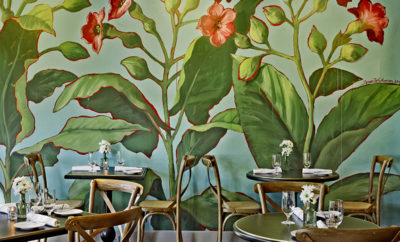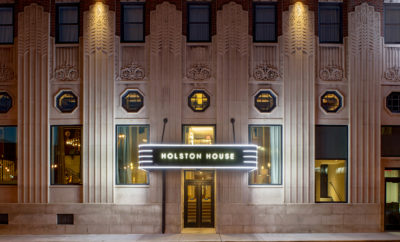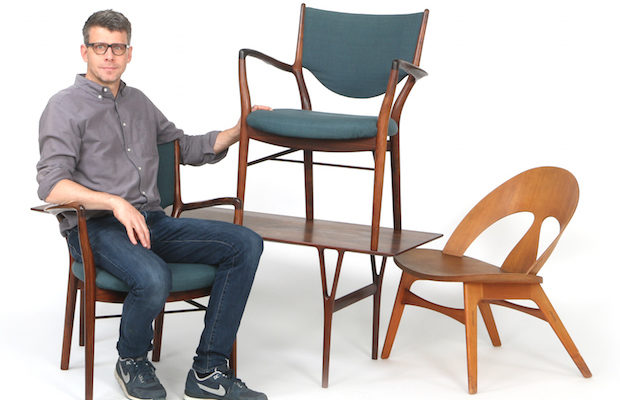 ALL IMAGES COURTESY BRUUN RASMUSSEN AUCTIONEERS
ALL IMAGES COURTESY BRUUN RASMUSSEN AUCTIONEERS
Design
“Buy What You Like”: Bruun Rasmussen’s Peter Kjelgaard on Collecting
MODERN HAD A WIDE-RANGING conversation with Peter Kjelgaard, head of modern design at Copenhagen-based Bruun Rasmussen Auctioneers on the eve of a landmark sale.
Modern Magazine: Tell us a bit about your background. How did you come to the world of design, in particular Nordic (or what in America we’d call Scandinavian) design?
Peter Kjelgaard: In the early 1990s I was studying political science at Aarhus University, aspiring to maybe become a diplomat or work in the EU system; but during my days in the library studying political culture and the pros and cons of Max Weber’s typology, my eyes somehow fell on the more colorful books on design, decorative arts, and architecture.
A particular eye-opener was Cara Greenberg’s Mid-Century Modern: Furniture of the 1950s. That was my first retrospective assessment of this rich period. At that time, Scandinavian design was almost forgotten in Denmark. A strange sort of medieval ignorance prevailed.
I recall going to flea markets around Denmark, noticing our cultural heritage being offered for nickels and dimes. And I still cry over passing up a Carlo Mollino brass and resin-flex “hoof” chair that Cara Greenberg had enabled me to identify—and that somehow had found its way into a small antiques shop in Copenhagen. For some time I was collecting (or more correctly hoarding) furniture, ceramics, lamps, etcetera. At some point, I decided to discard my college degree, and opened my first design shop. After some great years as a dealer, I was asked to join Bruun Rasmussen in 2005.
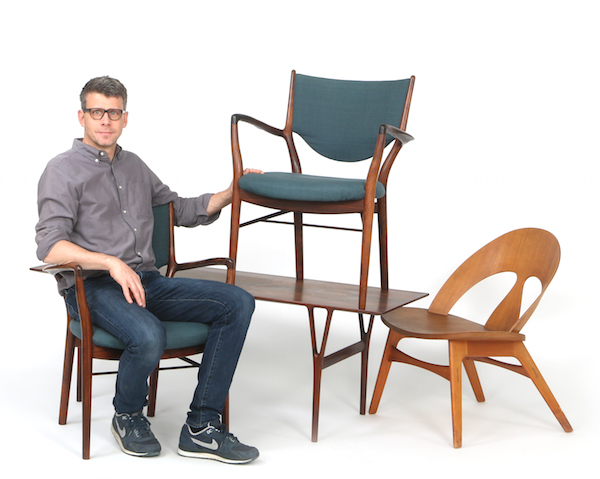
Peter Kjelgaard, head of the modern design department at Bruun Rasmussen Auctioneers, seated in an FJ-46 chair, designed by Finn Juhl, 1946, made c. 1950s; another example of the FJ-46 chair is atop a table designed by Helge Vestergaard Jensen, made by Peder Pedersen, 1960s; at the right is a Shell chair designed by Børge Mogensen in 1949, made by Erhard Rasmussen 1950–1955.
MM: I know the market has its ebbs and flows. Do you see interest in Nordic, or Scandinavian, design growing these days? Are there new markets? Is Asia a growing market?
PK: Mid-century modern, including Scandinavian design, is now a mature market. Most of the obvious gems have been discovered and reappraised by the market, but I think the market is growing in three directions. One direction is into the past—the early origins of Scandinavian modern. You could say that mid-century is being pushed back into the 1930s and in some cases even 1920s. This is the exotic past, with pieces that are often unique, made, for example, by a very young Arne Jacobsen for a specific project.
A second direction is into quality—pieces of exceptional character. Iconic pieces in original condition are going up in value, and special pieces by well-established names are rising to new levels. Still, each season can have its own trend, so we can see ups and downs for individual pieces and designers, within an overall positive trend.
A third direction we see is geographical. While Japan, Europe, and North America remain pillars of the design market, we see new buyers from places such as Lebanon, Taiwan, China, Hong Kong moving into the market. I think that as Asian buyers become more informed about Nordic design, they will move toward it as a subtle display of wealth and sophistication. Also, Danish furniture, with its emphasis on craftsmanship and history, plays well into the respect for tradition in Asia.
MM: Speaking of designers in and out of the limelight, in recent years there’s been a strong resurgence of interest in certain designers, among them Finn Juhl. Can you discuss his importance?
PK: Finn Juhl was probably the first Danish mid-century designer to be reappraised, and in many ways the interest in his work has been instrumental for much of the general interest in Scandinavian design. In his own time, he was the first Danish architect and designer to receive international recognition. His importance as a designer and the quality of his work goes without saying. But for a collector, he also meets a lot of criteria for being highly collectible. First, over about three decades he designed a lot of pieces (though not too much to over-saturate the market), almost all of them well documented. Second, some were designed to be made by hand, some in small factory serial production, and some for mass production, but the objects from all these levels have held high relative value, and they may be used together with no problem.
MM: Bruun Rasmussen is selling two Finn Juhl pieces this fall, both of them—especially the coffee table—rare and consequential. Can you speak a bit about their provenance and significance?
PK: Yes, they are two of the most amazing Finn Juhl pieces we have ever seen. They were originally purchased around 1945, and then passed to the first owner’s son. When the son died, they were left in a summerhouse while the family figured out what to do with them. I was contacted to see if, against their own judgment, the strange table had any value. When I came to see the table I found the chair next to it!
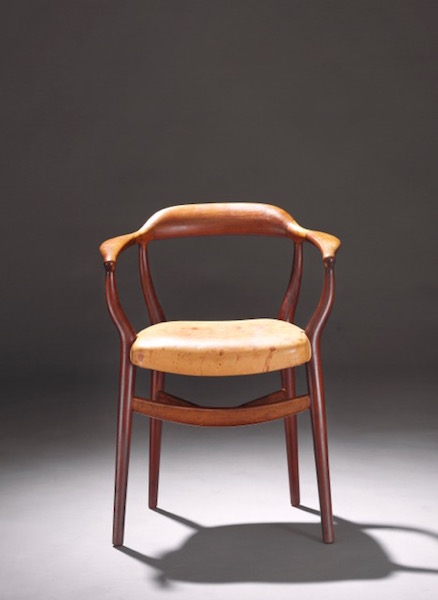
FJ-44 chair designed by Juhl, 1944, and made
in Cuban mahogany by Vodder, 1945.
The chair is the FJ-44 chair from 1944, executed in Cuban mahogany. It marked a turning point for Juhl, where he threw all his sculptural sensibility into wood—stretching what cabinetmaker Niels Vodder could do to the limit, and actually beyond. According to legend, only twelve were made. The model remained Juhl’s personal favorite, with one example in his own home. Over the years only two or three have reached the market as far as we are aware.
The table is the long-lost table from the Copenhagen Cabinetmakers’ Guild exhibition of 1945, which is known from references and photographs in contemporary articles and in books about Juhl’s work. It’s impossible to appreciate the full beauty of this piece from those black-and-white photos. Juhl was a great admirer of the work of Jean Arp, and in many ways the table is a three-dimensional homage to Arp. It is also a testimony to Juhl’s unique ability to use color and combine various materials such as glass, metal, and wood into one piece—it’s functional as a table but is basically a work of art. As a contemporary critic wrote in 1945: “We can always afford to dream.”
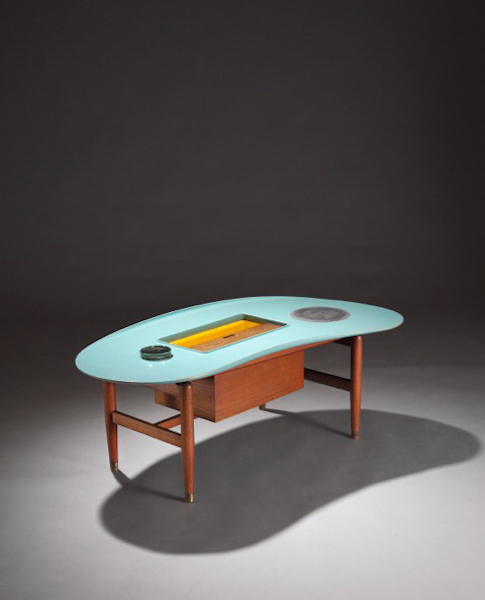
Coffee table designed by Juhl and made by Niels Vodder, 1945.
In my opinion this is the most important Finn Juhl table ever to reach the market, and possibly the best he ever made—it’s early and from his most fertile period, and possesses all the qualities you wish for in a piece by Juhl. It was made by Vodder and is clearly documented, highly sculptural, has never been on the market, and retains the original colors from 1945.
MM: Young collectors seem particularly interested in Danish furniture. What would you advise a young collector to buy? Are there designers who are noteworthy (and collector-worthy) but less well known?
PK: I always advise to buy what you like. There are so many great pieces of Danish furniture, and great values if you are able to deal with restoration yourself. But if you are starting out to build a serious collection, and looking partly to what could be the smart choice money-wise, then I recommend beginning with a few blue-chips—such as the Finn Juhl 45 chair made by Vodder. I would maybe get a pair of “the Chairs” by Hans J. Wegner, made by Johannes Hansen and with cane seats. Also, a round Mogens Lassen Egyptian coffee table in rosewood or Cuban mahogany, made by A. J. Iversen. One of the designers to look for right behind Juhl and Wegner could be Børge Mogensen. Other names to consider: Helge Vestergaard Jensen (exceptional quality, sometimes with a surprising use of nylon string), and the duo Ejner Larsen and Aksel Bender Madsen.
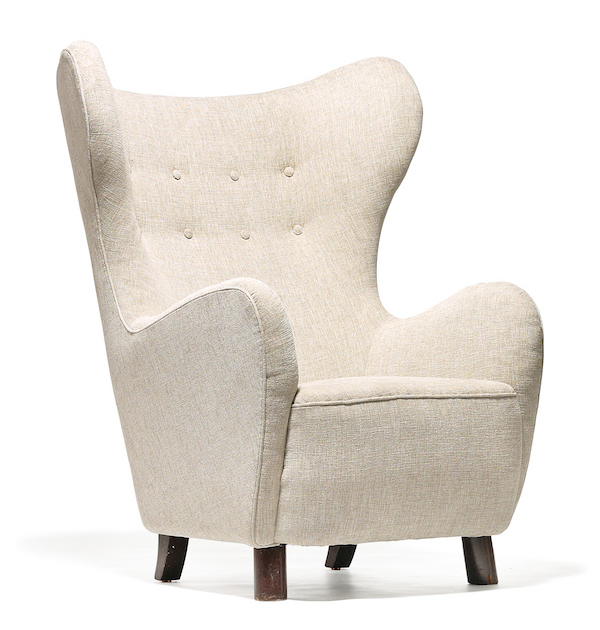
Wingback chair designed by Kay Fisker c. 1941, manufactured 1946–1949 for use on the ferries M/S Kronprins Frederik and M/S Kronprinsesse Ingrid.
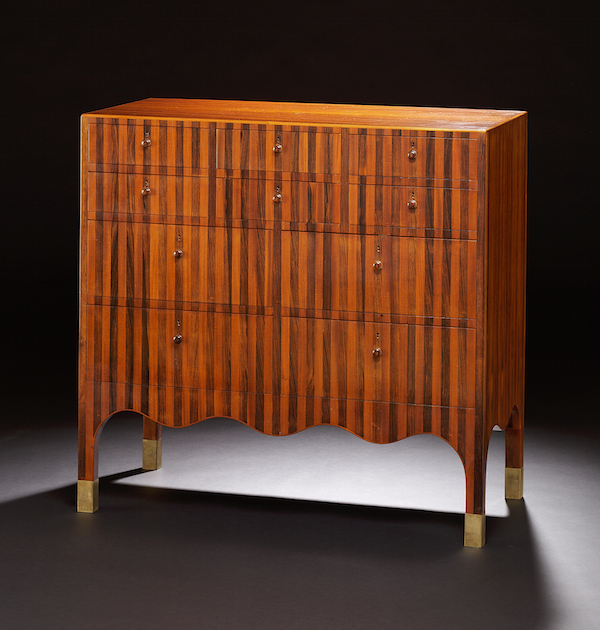
Chest of drawers designed by Tove and Edvard Kindt-Larsen and made by Gustav Bertelsen, 1947. The front and sides are veneered with alternating bands of rosewood and Cuban mahogany, the top is African mahogany, and the legs have tall brass “shoes.”
MM: And what would you say to an experienced collector looking to expand more into the Nordic/Scandinavian arena?
PK: For the experienced collector my advice would be to look for Kaj Gottlob, Kay Fisker, Mogens Koch (not the bookcases), Frits Schlegel, Mogens and Flemming Lassen, and early pieces by Tove and Edvard Kindt-Larsen. The prewar modern pieces by these names are part of what I label the exotic past. They were often made in extremely limited quantities, and can be in need of careful restoration, reupholstering, etcetera. The unique character means that no clear price references exist, so a fair market value can be hard to predict. On the other hand, when they appear, you cannot wait for the next one, as that could be never!



